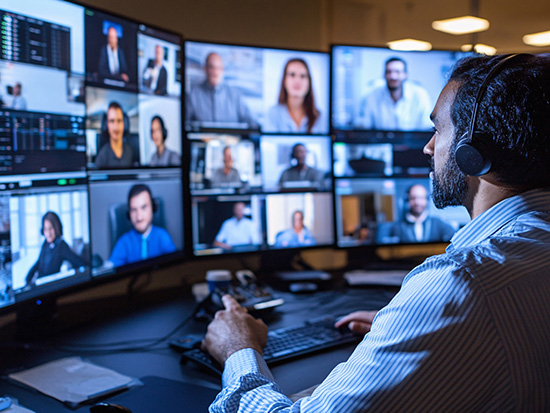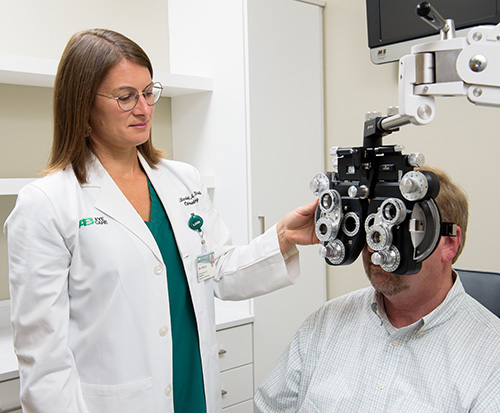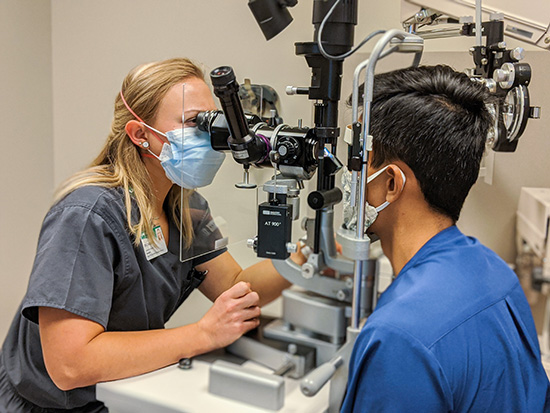 Digital eye strain caused by prolonged screen time can be reduced by proper vision correction, posture adjustments and regular breaks.Screens are not avoidable, but eye strain is. As people spend more time in front of digital screens than ever, device usage and eye comfort have become competing priorities. Incessant screen usage causes digital eye strain, or DES, an eye condition also known as computer vision syndrome.
Digital eye strain caused by prolonged screen time can be reduced by proper vision correction, posture adjustments and regular breaks.Screens are not avoidable, but eye strain is. As people spend more time in front of digital screens than ever, device usage and eye comfort have become competing priorities. Incessant screen usage causes digital eye strain, or DES, an eye condition also known as computer vision syndrome.
While lessening exposure to screens mitigates digital eye strain, sometimes it is inevitable due to people’s nature of job and education-related responsibilities. Elizabeth Steele, O.D., associate dean for Clinical Affairs at the University of Alabama at Birmingham School of Optometry, shares her expertise to reduce digital eye strain without avoiding the unavoidable –– screens.
Digital eye strain
Increased computer and device use can be associated with a variety of symptoms that include:
- Eye fatigue/eye strain
- Blurry vision
- Difficulty focusing
- Headaches
- Ocular discomfort such as dry, watery or itchy eyes
- Neck and shoulder pain
Neck and shoulder pain may seem unrelated; but according to Steele, poor ergonomics at your desk, meaning bad posture, can go hand in hand with eye strain.
“A lot of times, neck and shoulder pain occurs because of how we must position our head to see clearly through our glasses,” Steele said. “A standard bifocal or progressive lens, for example, often requires the head to be tilted back for the eyes to see through the bottom section of the lens. These patients benefit from a computer lens design instead.”
 Digital eye strain is also known as computer vision syndrome.Why do I have eye strain?
Digital eye strain is also known as computer vision syndrome.Why do I have eye strain?
Eye strain can occur for one or more reasons, including something as simple as an inappropriate eye prescription or lens design or as complex as an underlying ocular condition.
“The use of computers and other digital devices requires the eyes to focus on details up close, increasing the demand on the focusing system,” Steele said.
Eyes are most comfortable looking far away, and distance viewing requires the least work. The usual computer-to-eye distance, however, is between 16 and 20 inches, requiring the eye to work harder.
“The closer the device comes to the eyes, the harder the focusing or accommodative system must work to keep the image clear,” Steele said. “For many people, this alone leads to eyestrain, headaches and visual discomfort.”
Eye strain is even more likely with smartphones and tablets, as the average viewing distance shrinks to only 8-12 inches. Furthermore, the need to continuously change focus through the day with different tasks puts further demands on eyes to adjust.
On an average workday, people change their focus up to 333 times per hour, requiring the eyes to adjust.
People with existing ocular conditions may be more vulnerable to eye strain and discomfort. Dry eye and other ocular surface conditions can be exacerbated by prolonged screentime.
“Using screens is also associated with less blinking, which prevents normal expression of eye fluids, leading to dry, uncomfortable eyes,” Steele said.
Eye alignment disorders, most common in children and young adults, can lead to eyestrain, and can be addressed with special glasses or vision therapy.
Other contributors to eye strain are the blue light and flicker emitted by devices.
 Thorough and regular eye exams are critical to securing an accurate prescription.
Thorough and regular eye exams are critical to securing an accurate prescription.
Photography: Satina RichardsonCurbing eye strain
The first and foremost step to avoid eye strain is effective vision correction, which goes beyond an updated prescription, Steele says.
“Effective vision correction means that eyes have the support they need to accomplish each task and to adjust to different focus modes with different tasks,” Steele said. “This is addressed with glasses or contact lens power, and lens quality, coatings, design and fit.”
To avoid visual discomfort, Steele recommends being mindful of the following:
- Accurate prescription: Get a thorough eye exam and use the most updated prescription.
- Lens quality: Fast and online lens purchases may provide poor lens quality, which can lead to image spread and imperfection, interfering with visual comfort.
- Lens design: The lens design should fit the patient’s needs. Utilizing computer lenses, anti-fatigue lenses or personalized progressive lenses can help reduce eye strain for particular tasks. Progressive lenses are designed to transition smoothly with different focal lenses, correcting for vision at all distances.
- Lens coating: Anti-reflective coatings cut glare from the patient’s and the viewer’s perspective. Blue-light blocking coating or lenses reduce impact of blue light.
- Computer position: Avoid placing screens directly in front of a window, which will increase reflections on the computer screen.
- Modify device settings: Go for what “feels” comfortable. Adjust brightness, contrast and color as needed. Consider software applications that minimize blue light and flicker.
- Workspace considerations: Optimize the screen distance and height. The top of the screen should be at or slightly below eye level.
There is no scientific evidence that blue light from routine use of personal devices causes eye damage or blindness. However, blocking blue light may reduce eye strain and improve sleep quality.
"When working on screens, take 20 seconds to look at least 20 feet away every 20 minutes,” Steele said.
Visit UAB Eye Care for the most optimal solution to reduce digital eye strain. UAB Eye Care provides routine and emergency eye care, the latest optical styles, and specialty services.